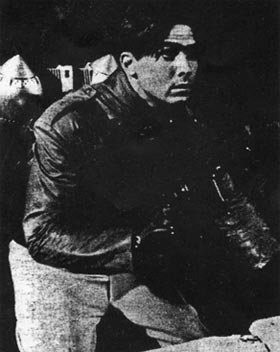Return of the B Movie
The Rocketeer
Screenplay by Danny Bilson and Paul de Meo
Directed by Joe Johnston.
A Walt Disney Pictures Release.
Crisis/September 1991
As a father who has read aloud about 3,500 children's stories in the past ten years, I have concluded that it is a sign of artistic brilliance to be able to appeal to children while not driving a parent to tears of boredom or bouts of nausea. I loathe intensely The Poky Little Puppy; I have banished all the Berenstain Bear books from the house; and I cannot tolerate "Sesame Street." On the other hand, I look forward to rereading the Little House on the Prairie series, or even the Borrower series. Similarly, family movies can be hard on the paternal nerves-- or they can be a pleasure. Walt Disney Pictures has come up in The Rocketeer with a modern Grade B movie that for different reasons will delight both parents and children.

Bill Campbell as Cliff Secord
A backpack rocket invented by Howard Hughes is the object of the mob's attentions. In 1939 it falls into the hands of a handsome flyboy, Cliff Secord (Bill Campbell) with an actress girlfriend, Jenny Blake (Jennifer Connolly). An Errol Flynn-type figure (Neville St. Clair, played by Timothy Dalton) is the evil genius who directs the attempts to get the rocket, and it turns out he is in the service of the Nazis. After many chases, Truth, Justice, and the American Way triumph in the end. The movie was based on a graphic novel (i.e., comic book), but I detect its ultimate ancestor in Rocket Ranger, a computer game my children never tire of playing.
I enjoyed the chase scenes, but then I fear that like Chesterton and Robert Louis Stevenson I have never really grown up. My children not only enjoyed the chases but saw the jokes in their outrageousness. Those of us who wasted our childhood watching old B movies on TV are able to recognize in The Rocketeer all the ingredients of that American genre: the boy-loses-girl, boy-regains-girl plot, the monsters, the mobsters, the G-men, the Nazis. This movie puts them all in the same pot, and stirs. There were wartime propaganda films in which the gangsters fought the Nazis: "See youse guys, they're a big mob that won't let us little guys get our piece of the action" (Hollywood had an insight into the nature of totalitarian states that has escaped many learned neo-Marxist professors). In this movie, too, the mob and the FBI end up fighting side by side against the Nazis.
The Nazis are disappointing and have bad German accents, probably by design. The real-life ones were much more stylish and wicked. But everything else in the movie was just right: the bungalows, the roadside diners, the cars, the dresses, and especially the night club. When was the last time you saw a giant white oyster shell, floating in a pool that opened to reveal a torch singer belting out "Begin the Beguine"? Neville St. Clair is clearly Errol Flynn, who I believe was accused of having Nazi sympathies. Clark Gable and W.C. Fields also make brief appearances.
St. Clair is always acting, and in the seduction scene he tries out the choicest lines from his movies on Jenny, who recognizes them, and is not impressed. The film plays with its constant references to B movies and a more innocent past (the actress lives in a house with a house mother who sets an 11 P.M. curfew) and with the idea of sex roles. By delightful coincidence, Campbell and Connolly, who first met when they were working on this movie, fell in love and are now engaged. They liked the roles they were playing.
The male and female roles are Old American and pre-feminist: the handsome, boy- ish hero, who is inarticulate but incredibly brave; the spunky, wisecracking girlfriend, who at first looks shallow but comes through in the end.
The movies of the 1930s and '40s generally had their hearts in the right place (with some help from the Hays office), and their warmth and humanity survive in this reincarnation.
It is all very charming because the playfulness never degenerates into mockery, even in the scene in which the Rocketeer blasts off in front of the spotlighted American flag to attack the Nazi Zeppelin. For those of us who fought in the War, or whose parents fought in the War, there is an inescapable pathos in such scenes. The flyers of the 1930s and '40s were so young that to fly they needed their boys' lucky charms, such as Secord's chewing gum. Precisely such very brave and very young men would be flying in a few years against the Axis powers, and many wouldn't come back.
Leon Podles, medievalist, G-man, and father of six, occasionally writes about the talking pictures.
|
